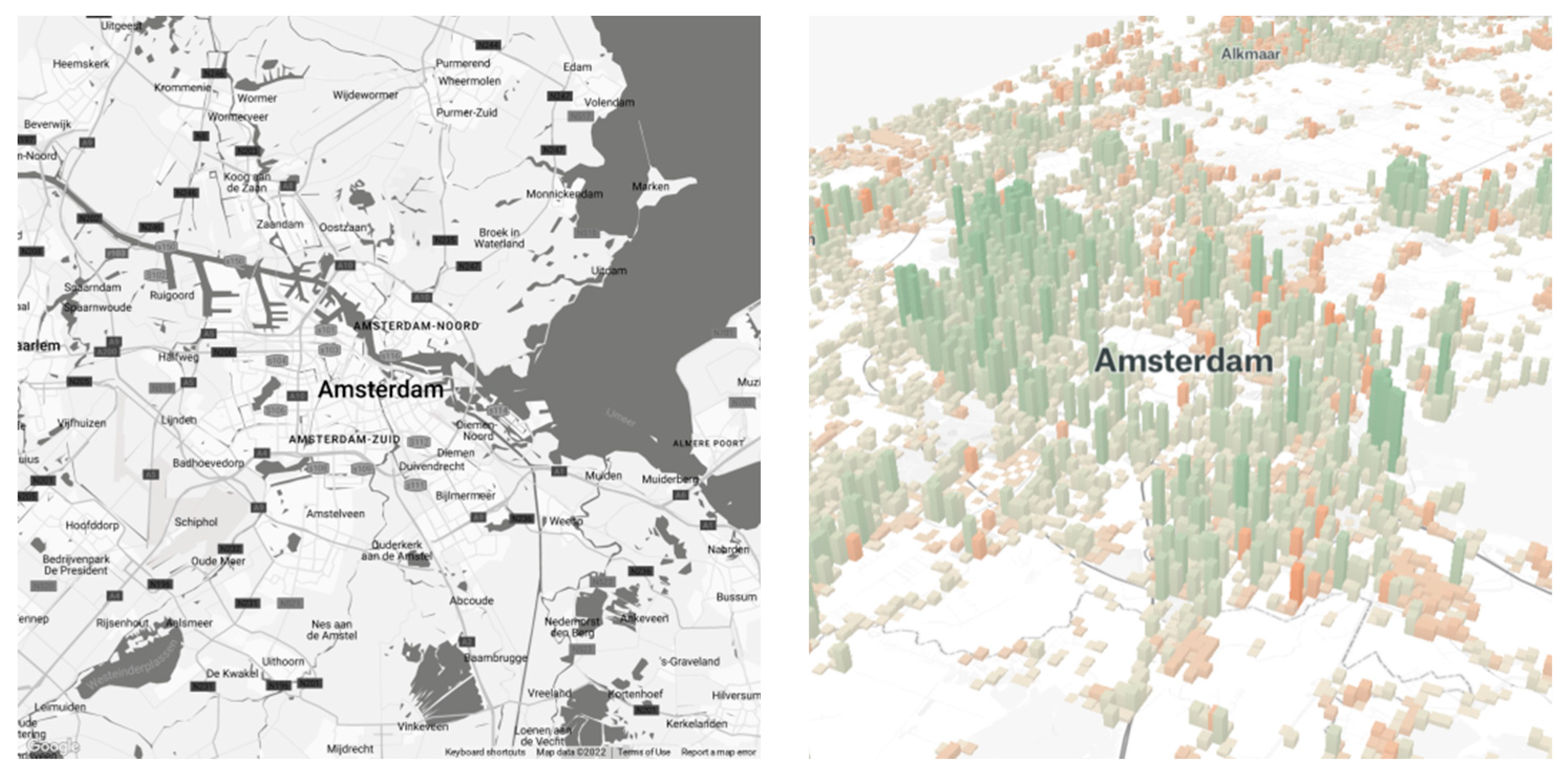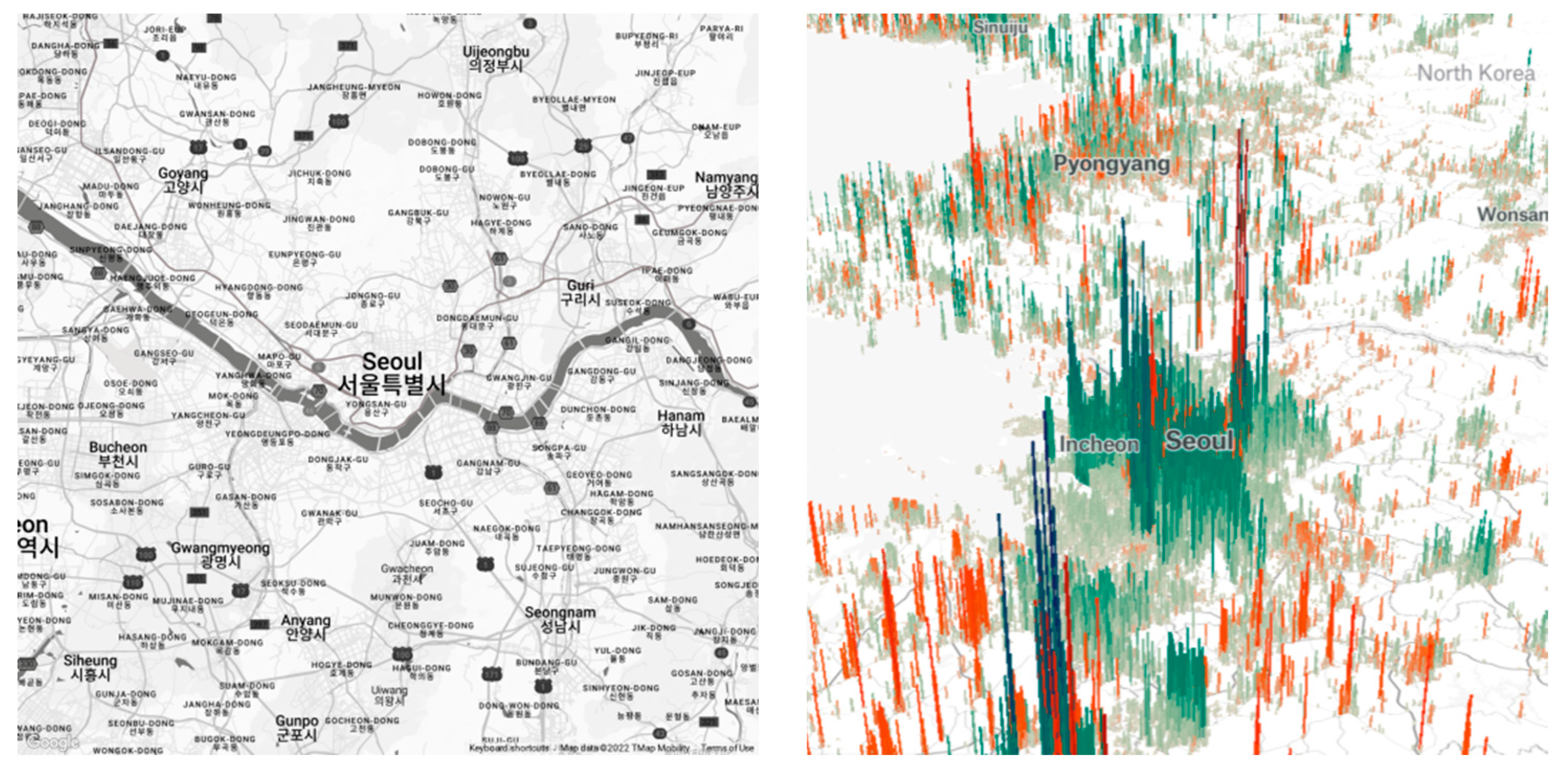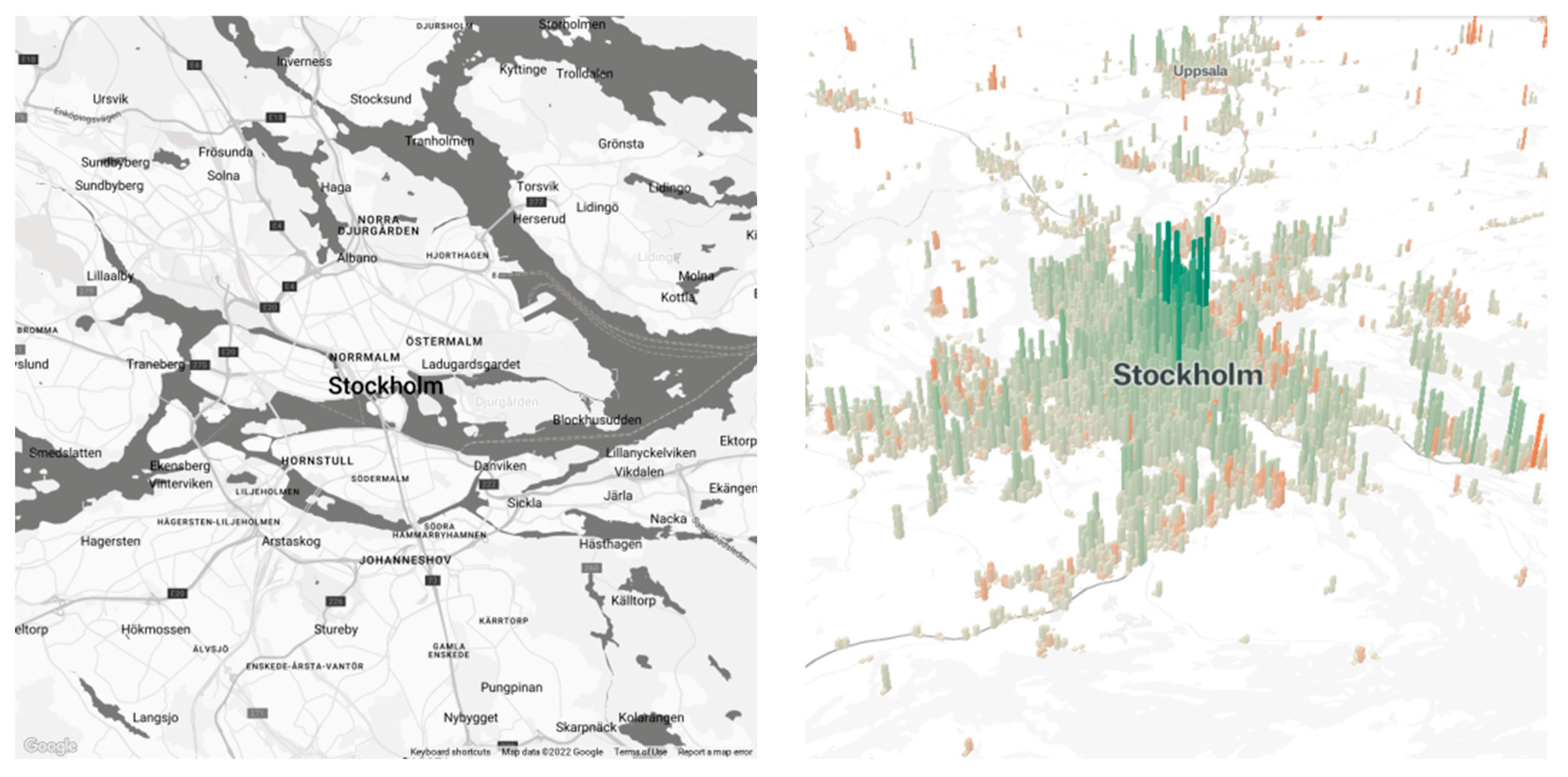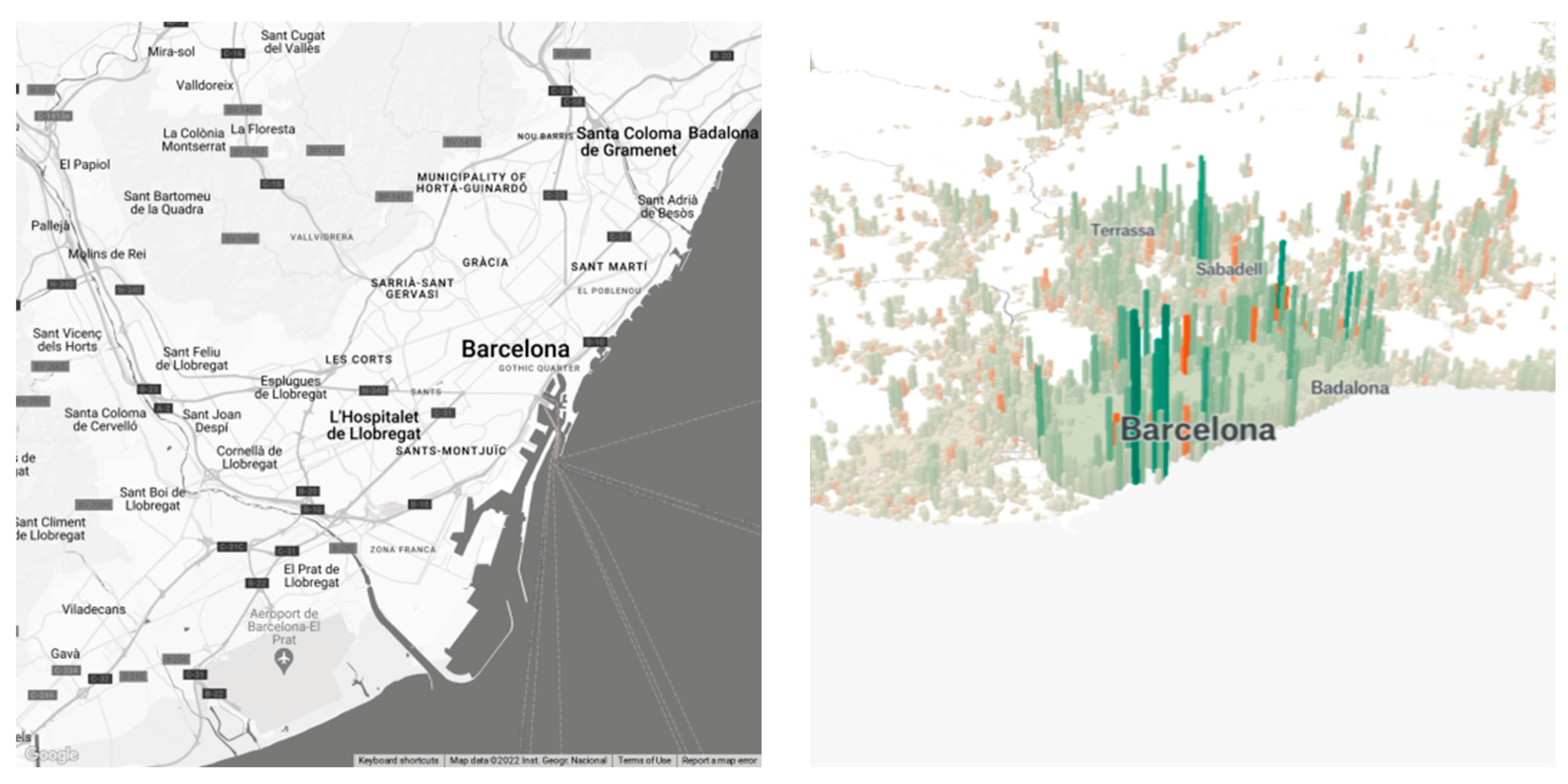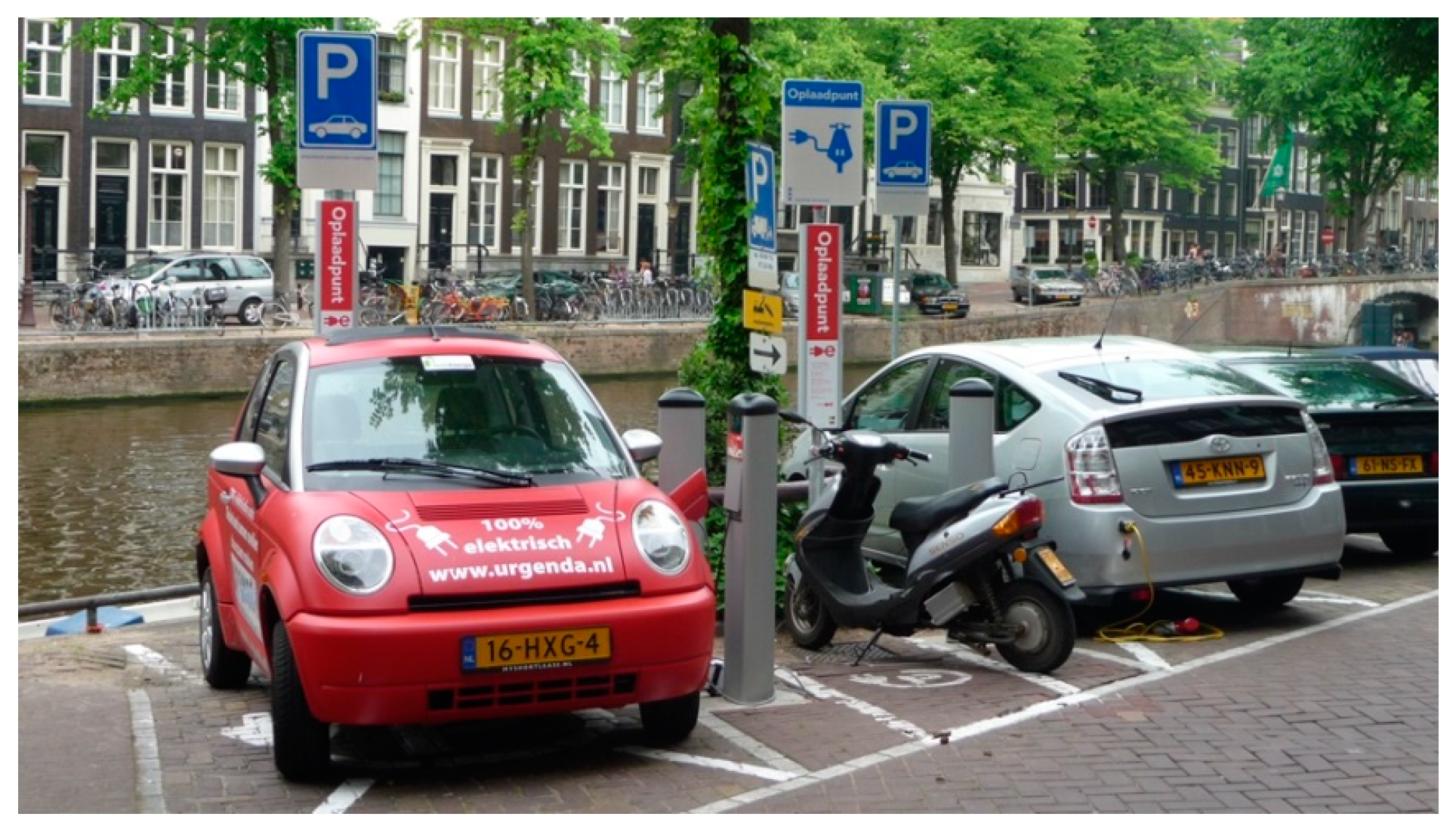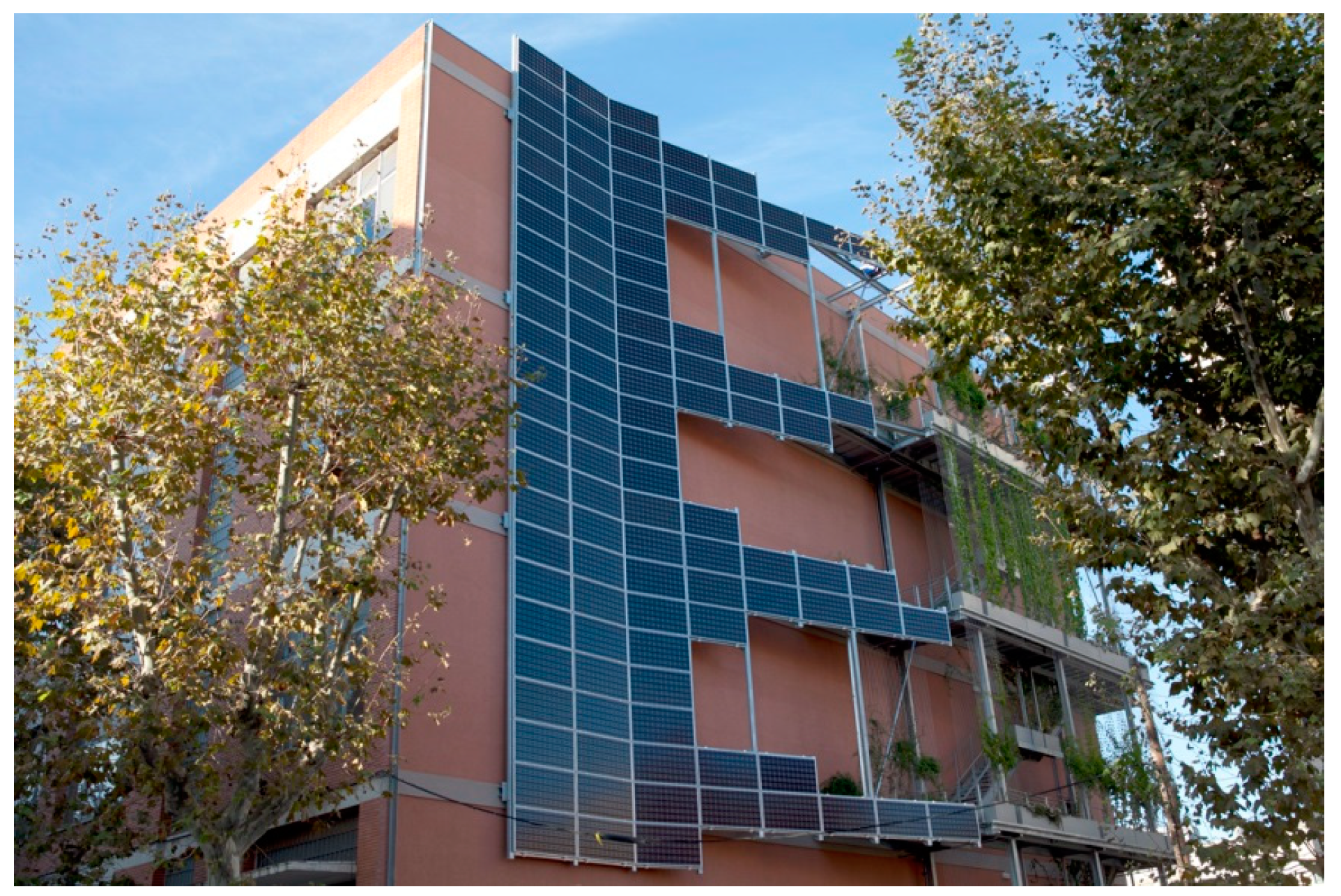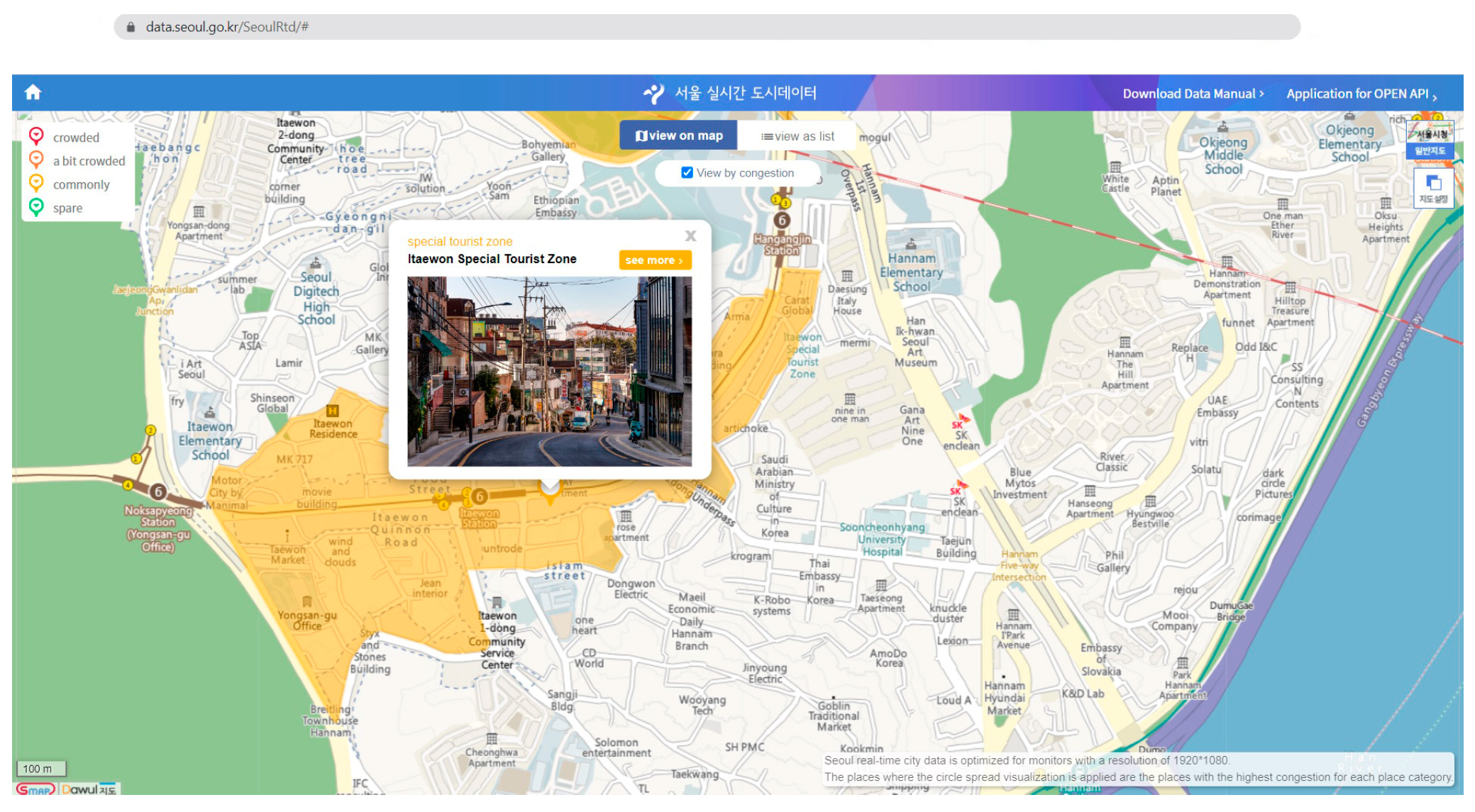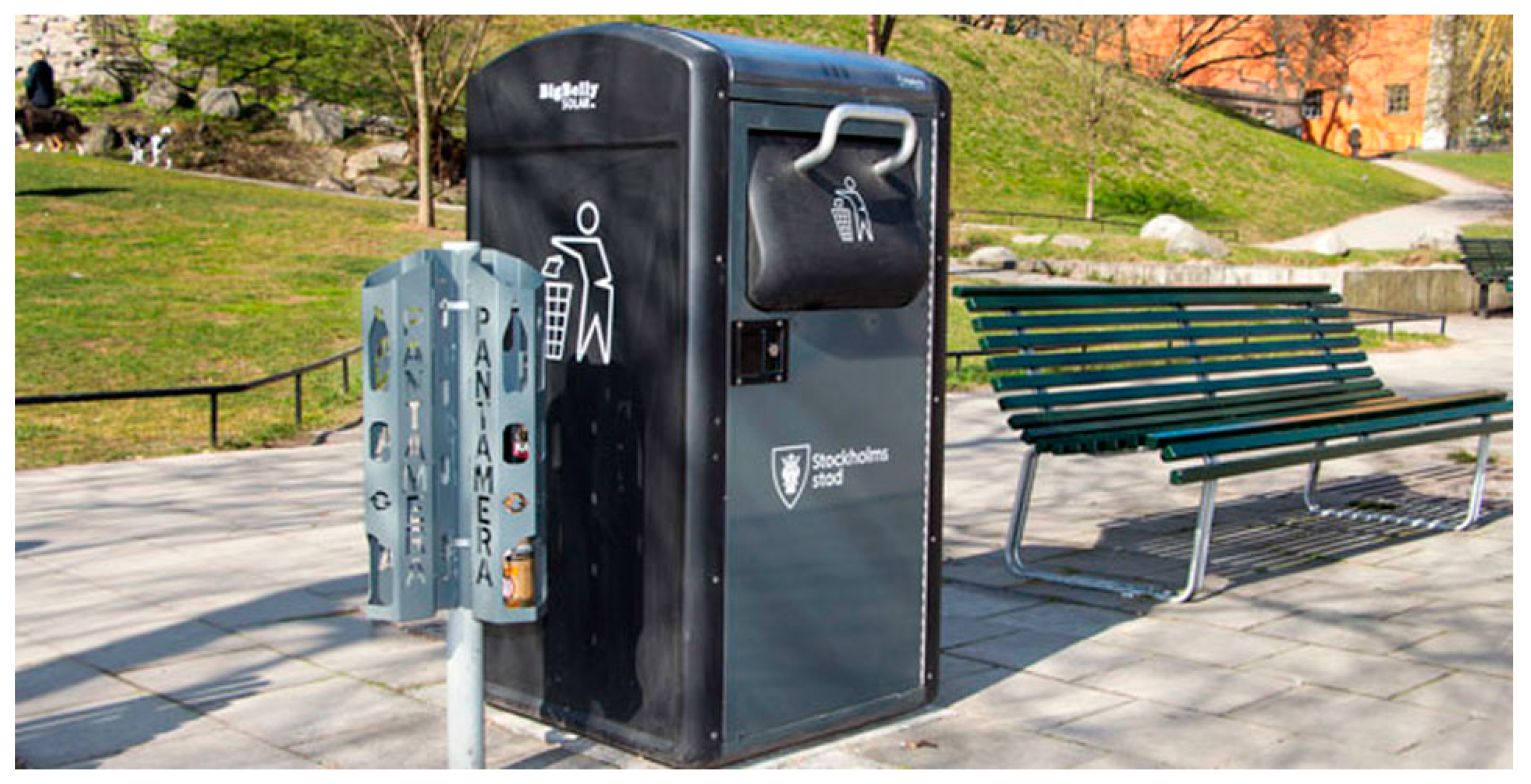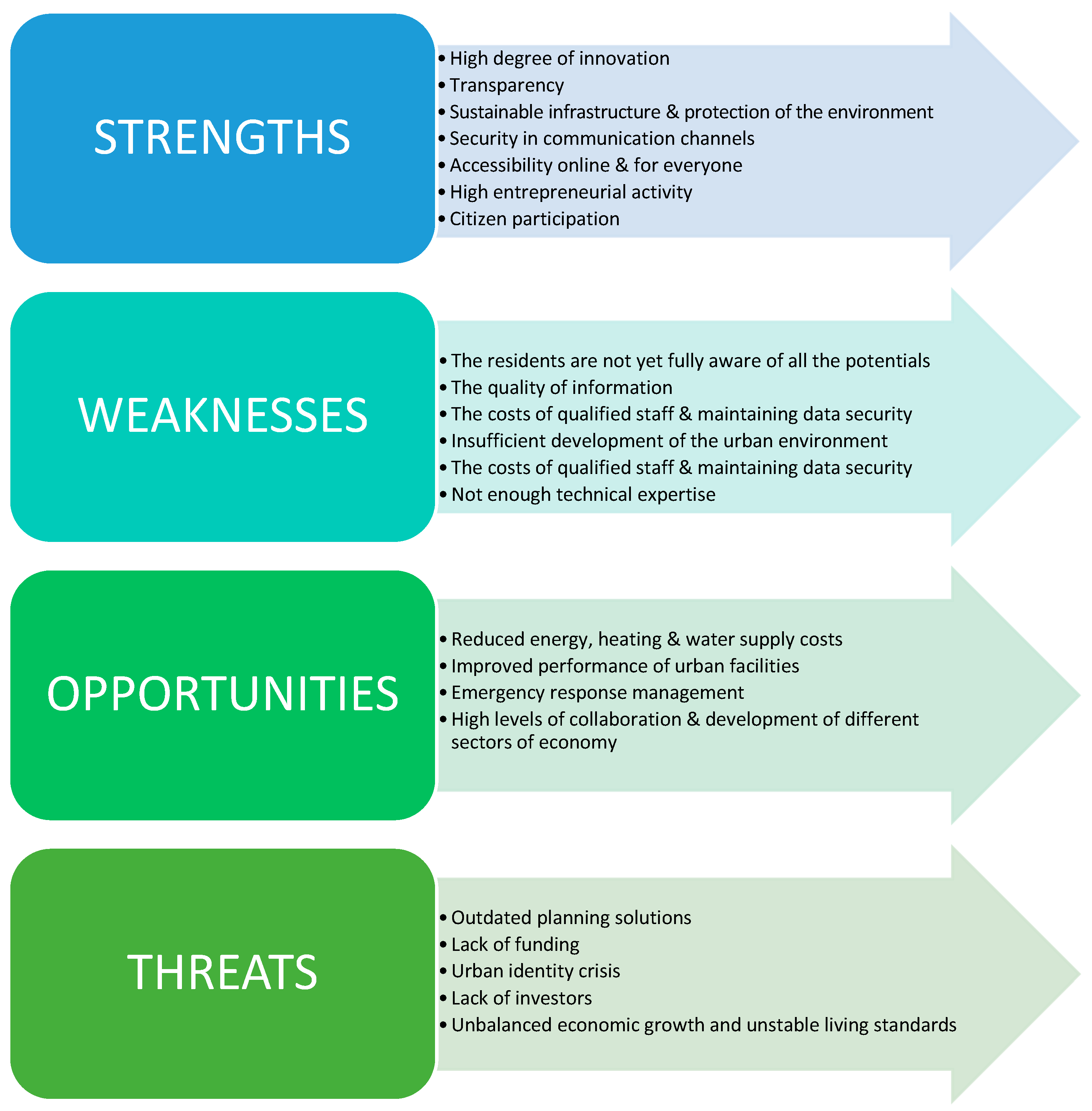1. Introduction
By 2030, megacities or dense metropolitan regions will house almost 60% of the world’s population [
1,
2]. However, urban growth has a price. Many metropolitan cities across the globe have begun to focus on sustainable growth through regulated urban expansion in response to a variety of infrastructural issues, together with social and environmental constraints [
3]. Indeed, during the last decades, inner cities around the world have been involved in multifaceted initiatives to improve urban infrastructure and services, with the target of a healthier and more resilient environment [
4]. These initiatives were also aimed at reaching social and economic prosperity [
5], improving local competitiveness [
6], and making cities more appealing [
7], with a view to benefiting from tourism [
8]. However, it is the smart city concept that outlines how cities might attain such long-term development objectives; therefore, the smart city notion is earning popularity amongst governments and local/regional authorities [
9].
The development of smart cities of interest for tourism purposes is likely to generate significant effects on real estate sustainability, as it may add value to assets and therefore exponentially increase profit yields, customer trust, and strong market rivalry [
10,
11]. Indeed, information technologies (see [
12]) include tools for offering better services to residents, as well as tourists, on the one hand, and the necessary means to endorse global real estate growth within smart city perspectives, on the other hand [
13,
14]. However, given (i) the demographic, social, and technological developments’ effects on the built environment, which are becoming increasingly prominent in property investment decisions and development trends, and (ii) the real estate sector’s high uncertainty and unpredictability, the smart city plan should also emphasize improvements in the economic, social, cultural, ecological, and governance dimensions. This specific aspect of the literature is relatively poorly developed in recent studies, despite the direct linkage to a specific sustainability target of the Agenda 2030 (see [
15]), namely Sustainable Development Goal (SDG) 11, facing ‘sustainable cities and communities’ and the indirect linkage to other sustainability targets such as SDG 9, ‘industry, innovation and infrastructure’, and SDG 15, ‘life on land’. The policy and planning implications of such studies are clearly useful when implementing a comprehensive strategy for sustainable and resilient tourism-specialized cities, reducing the environmental impact of economic activity and improving the economic viability of investments, settlements, and infrastructure [
16,
17,
18]. Faced with this situation, the current work will seek to understand and determine how advanced digital technologies within and without, culturally driven sustainable development and growth, and real estate planned or unplanned development can be considered expressly or by implication inextricably inalienable and inseparable, and at the same time how these components can empower cities of the future in effectively establishing a unique framework towards branding themselves as growing, smart, resilient, and sustainable tourist destinations. The present study is articulated in sections, delineating the most relevant and updated literature review in the field of tourism-specialized cities (
Section 2), the methodology used in the present contribution (
Section 3), and a thorough description of relevant case studies, in accordance with the main limitations emerging from the literature review (
Section 4).
Section 5 discussed the main findings of the present contribution in light of sustainable planning and policy for resilient city regions oriented toward an economic specialization in tourism.
Section 6, finally, concludes the work by specifying the need for future studies and novel approaches to urban complexity.
2. Literature Review
Several definitions of the ‘smart city’ exist in the scholarly literature [
19]. Earlier studies argue that the smart city concept arose as a result of the goals set by the 1997 Kyoto Protocol (see [
20]), which qualify certain initiatives and plans for urban development as ‘smart’ [
21]. A predominant view sees a smart city when investments in human and social capital and in traditional and modern communication means and infrastructure fuel sustainable economic growth as well as high quality of life, while managing natural resources, as achieved by participatory governance. Another definition notes that a smart city is considered a city that performs a number of fundamental functions, such as smart economy, intelligent mobility, smart environment, smart people, smart living, and smart governance, based on the ‘smart’ combination of endowments and activities of self-regulating, independent and sensitive citizens. A more technical definition states that a smart city is an urban space that combines information and communications technology, as well as participatory web and social web technologies, and includes other organizational, planning, and scheduling efforts to dematerialize and expedite bureaucratic processes and assist in identifying innovative solutions for better city management and increased living standards [
22].
The notion of the ‘smart city’ was initially introduced in the early 1990s in the book entitled
The Technopolis Phenomenon, by [
23]. This source predicted the emergence of a basic linkage between technology and urban development, which would contribute towards ensuring quality living. The development process would take place through collaboration between academia, governments, and industry, using faster networks capable of supporting the innovative smart city model globally [
24]. A few years later, this concept was analyzed assuming the central role of cities in controlling and integrating the conditions from all infrastructures, including transport networks, communications, water resources, energy, and structural wealth [
25]. The primary goal was to strengthen resources, provide a more comprehensive framework for their maintenance and upkeep, monitor security provision, and improve citizen services [
26]. A smart city is also identified as a well-functioning and integrated urban landscape, looking to the future in the economy, people, governance, mobility, and livelihoods, built on a smart combination of skills and activities of a community-independent and self-sustaining environment [
27]. Other scholars have examined the term from the user’s point of view, proposing a new framework and defining the adaptability of technology as user-friendly [
28]. In general, the smart city model extends beyond the physical boundaries of the structured networks and describes an environment of networks that connect virtual and physical spaces to meet the various challenges that a modern city has to face [
29].
The smart city model is approached as the evolution of city models such as the creative city, the digital city, the city of knowledge, the living city, the smart green or the sustainable, the cultural, and the smart city [
30,
31,
32], which were developed with the aim of achieving urban sustainability based on technological infrastructure. An ‘intelligent community’ that uses technology directly and effectively to meet its social and business needs will inevitably build high-speed internet infrastructure. An alternative approach is to improve urban functioning through the use of data, information, and information technologies in order to provide more efficient services to citizens, in order to achieve the control and optimal operation of infrastructure, increase cooperation between different economic actors and promote the creation of innovative business models in both the public and private sector [
33].
In addition to academia, a number of public sector institutions have also worked on the smart city issue. For instance, the city of Barcelona defined a smart city as an intensive and advanced high-tech city that connects people, information, and city elements with the use of new technologies to create a sustainable, green city, with competitive and innovative trade and increased quality of life. In recent planning documents, the city of Amsterdam claimed that the smart city uses innovative technology and intends to change consumption behavior in order to meet climate targets [
34]. Towards this approach, the Amsterdam Smart City is a city project designing and developing an environmentally and economically viable context that will reduce the city’s carbon footprint [
35]. Earlier in the city life cycle, the first version of the smart model of Singapore was introduced, the transformation of which into a new information economy using technology would be successful due to the lack of natural resources and the need to review the traditional industrial base of the regional economy [
36]. In 2001, the Edinburgh government invested in technology infrastructure to turn the city into a pilot technology center based on smart governance. Trikala digital city in Greece hopes to become a digital data prosumer and promote smartness and resilience, developing an e-Government environment that offers more than administrative services, benefiting both residents and the administrative authorities [
37].
It follows that integrating information and communication technologies (e.g., the internet of things) in urban environments is of particular interest, as it responds to the strong push (see also [
38]) of many administrative authorities to tackle everyday challenges with practical solutions, thus realizing the general idea underlying smart cities [
39]. Urban governance can, in fact, benefit the management and optimization of traditional public services, such as transportation and parking, lighting, surveillance and maintenance of public spaces, preservation of cultural heritage, waste collection and sanitation, hospitals, and schools [
40,
41]. In addition, the availability of various types of digital data, collected by widespread urban information and communication technology, can be used to increase transparency and promote local government action to citizens, to raise public awareness of the state of their city and, consequently, boost the active participation of citizens in the management of public administration, as well as the creation of new services [
42]. On the other hand, information and communication technologies can be used as a successful matching of push and pull motives for an online marketing strategy in destination areas, for example by placing significantly greater importance on social media content about the destination’s cultural heritage and historical sites [
38,
43,
44]. Therefore, the application of the information and communication technologies scheme is particularly attractive to local and regional administrations [
45]. With this perspective, smart cities are commonly thought to be about new technologies; however, they are much more. The smart city is an expression of a very contemporary drive to envisage and influence the city’s and urban society’s future; a city featuring efforts for economic development, governance, transportation, and sustainable housing (see [
46,
47]). Unsurprisingly, the ‘smart’ initiatives could not be applied horizontally, and are—to a large extent—dependent on local governments and cultures, possibly unraveling how the development of smart cities has remained mostly heterogeneous [
48]. However, economic growth and other conceptual issues are considered influential in determining the ‘smart’ development and planning of any city [
49]. Attractiveness, for example, is a basic characteristic of smart cities, beyond tourist destinations. Developments with smart technology in cities, and/or particular sites, towards functioning more efficiently, are more attractive to residents and visitors considering the lower operating costs and the higher value retention [
50,
51].
Tourism and Smart Cities
Tourism is occasionally cited as one of many services that may be developed using smart city concepts, although it is rarely regarded as a core component in smart city development plans [
52]. In addition, notwithstanding large expenditures in upgrading urban services under smart city development, tourism professionals have largely overlooked smart city projects, which are generally absent from tourism development plans. In particular, according to recent studies, smart tourist destinations simply integrate information and communication technologies to speed up the creation and production of tourism-related operations [
53]. In other words, they engage with the tourists to co-create value, leisure, and experiences using the technologies already accessible [
54]. Connecting local stakeholders through a centralized channel/platform, in order to ensure community engagement, is crucial for bringing a smart interface to tourism destinations [
55]. Smart tourism destinations enable valuable information sharing between tourism companies and visitors.
This exchange is beneficial at all levels for all sides involved, namely by increasing the quality of life of the citizens, competitiveness through attractiveness for the city, profit for the tourist sector business, and leisure, pleasure, and experiences for the tourist. However, the boundaries between residential neighborhoods and tourism zones are blurred by smart tourism, which takes inspiration from smart city development [
56]. Historically, urban settings have been quite separated when it comes to tourism, with many cities creating designated tourist areas that virtually solely serve visitors [
57]. Residential areas were zoned out and away from tourist accommodation facilities, while additional tourist infrastructure, including gift stores, tourist-friendly eateries, sightseeing buses, and nightclubs, were built next to the hotels or near transit hubs, or within reach of heritage cultural sites or structures [
58,
59,
60]. This division is put into question by the integration of smart technology into urban settings, which is a powerful driver for the merging of touristic and residential uses of urban space. Therefore, smart cities with a growing tourist industry, inevitably have an evolutionary impact on the real estate industry (e.g., real estate tourism model [
61]) well beyond the environmental sustainability part offered by smart buildings. On top of that, second-home tourism [
62], a special aspect of tourist destinations, is a socioeconomic phenomenon that develops and grows almost concurrently with tourism [
63], which is nevertheless supported by a variety of complex driving forces for development [
64], including—but not limited to—the potential for real estate profitability [
65].
Thus, amid the smart city revolution and the commonly acknowledged added value offered by cultural (heritage) sites or buildings (e.g., seen as tourist resources) [
66,
67], real estate has inevitably become an integral part of the urban smart transformation. Since technology establishes a digital—now—connection between human behavior and surroundings (see ‘design theory’ [
68] and ‘actor-network theory’ [
66]), both the transformation of urban space into user-centric and existential space, way beyond the Cartesian notion of space in Euclidian planes (see [
69]), and the rising tendency of preserving built heritage (see, e.g., adaptive reuse [
70] under the ‘authenticity’ spectrum [
71]), in particular, provide an intriguing possibility for the Internet of (Cultural) Things and its applications, which are shifting the real estate nature, perhaps leading to the emergence of ‘smart real estate’. Indeed, using the contemporary digital means available creates sufficient space to set or improve interconnections among information technology (e.g., referring to ‘blockchain technology’ [
72]), urban cultural (heritage) sites and structures, city operations, services, space, and people (either residents or visitors), and enables a response to the global desire (or better yet necessity) for sustainable development in its broadest sense.
Against this background, the focus of the present work is on attempting to realize how enhanced technological throughputs and synergies, culture-led urban sustainability initiatives, and real estate are directly (or indirectly) related in practice, and how can these dimensions help contemporary metropolises better establish policies for promoting themselves as internationally sustainable and resilient tourist destinations. In this perspective, centered on four specific cities’ successful smart efforts, the current study goes forward with the development of a matrix illustrating strengths, weaknesses, opportunities, and threats (namely, the SWOT matrix [
73,
74,
75]). This will allow the ultimate discovery of how all players involved and local authorities will need to transform in order to offer better services to residents and visitors.
3. Methodology
To contribute to an in-depth understanding of the economic and developmental issues in a tourism-specialized context, a comparative, narrative analysis of representative cases of smart cities worldwide was developed here. The selection of the relevant cases was based on three main criteria: (i) cities where tourism is the primary component of the local culture and economy, (ii) cities that are prevailing in the global scholarly published literature as success stories or leading examples of destinations embracing smart technology, cultural backdrop, and catching-the-interest real estate, and (iii) cities where the data required to address the overarching objectives of the current study were available. Furthermore, the selection went through the examination of additional criteria, some of which seem essential to distinguish each city. This interpretative scheme may highlight the originality of the model that each city has followed and on what ‘smart’ features it is based. Examples include how the city approaches mobility, and what makes it special compared to other smart cities, or innovations supporting the objectives that the city has set, with the relative residents’ acceptance. A multiple set of criteria were therefore considered (
Table 1)—in accordance with the theoretical background (see
Section 2)—and provided a suitable final selection.
As an initial source, the list of the world’s smartest cities in the 2021 Smart City Index was used (
Appendix A Table A1).
Additionally, the present study moves forward with the development of a matrix collecting the strengths, weaknesses, opportunities, and threats (SWOT) of the smart city concept, in order to encapsulate the essential points made in the earlier analysis of the case studies. This illustrative summary attempts to identify how developers and local governments will need to change in order to deliver better services to residents and visitors. In other words, how to maximize strengths, avoid weaknesses, and capitalize on opportunities while minimizing dangers.
Study Cases
Basic information about the four cities investigated for the scope of the current research, namely, Amsterdam, Barcelona, Seoul, and Stockholm, are provided in an attempt to become acquainted with their key aspects.
Table 2,
Table 3,
Table 4 and
Table 5 present data in three time periods, particularly 2005, 2015, and 2020, which typically reflect the beginning and the progression of significant acts in the course of each smart city’s development. In total, the Amsterdam metropolitan region (
Figure 1) has developmental potential in terms of size and economy, as well as a reasonably high quality of life [
78].
Over the time period under examination, Amsterdam’s total population and population density grew and still remain relatively low, while unemployment rose in the first time point but declined in the second (
Table 2).
Table 2.
Amsterdam key quantitative features.
Table 2.
Amsterdam key quantitative features.
| Amsterdam | 2005 | 2015 | 2020 |
|---|
| Population of metropolitan area (individuals) | 2,156,348 | 2,275,130 | 2,406,043 |
| Total Area (km2) | 2819.84 | 2819.84 | 2819.84 |
| GDP (million USD) | 110,110 | 119,352 | 122,149.2 |
| Unemployment as % of national size | 14.49 | 14.60 | 14.50 |
Seoul’s profile differs significantly from that of European metropolises. The population is quite high, and the economy is dynamically upward but with a lower per capita income (compared to European cities) and a significant unemployment rate (
Table 3) [
79].
Table 3.
Seoul key quantitative features.
Table 3.
Seoul key quantitative features.
| Seoul | 2005 | 2015 | 2020 |
|---|
| Population of metropolitan area (individuals) | 20,190,367 | 22,244,241 | 25,562,729 |
| Total Area (km2) | 4673.13 | 4673.13 | 4673.13 |
| GDP (million USD) | 22,252.20 | 28,543.58 | 30,989.72 |
| Unemployment as % of national size | 46.36 | 55.23 | 57.13 |
In general, due to the large size and low density (
Figure 2), the city faces challenges in the quality of life as well as the environment [
80]. Significant unemployment and relatively low incomes also reflects a possible orientation of the city to the economy and entrepreneurship [
81].
Stockholm’s urban economy is growing dynamically (
Table 4) and is based on innovation and entrepreneurship [
82,
83]. The Stockholm metropolitan area presents an economic and population potential, with a relatively good quality of life without significant problems of administrative fragmentation [
84].
Table 4.
Stockholm key quantitative features.
Table 4.
Stockholm key quantitative features.
| Stockholm | 2005 | 2015 | 2020 |
|---|
| Population of metropolitan area (individuals) | 1,825,377 | 1,924,078 | 1,969,310 |
| Total Area (km2) | 7106.87 | 7106.87 | 7106.87 |
| GDP (million USD) | 91,135.32 | 107,609.7 | 123,274.12 |
| Unemployment as % of national size | 13.27 | 19.29 | 20.18 |
Stockholm has a small (for a metropolitan area) population size, with increasing trends but a relatively low population density (
Figure 3).
Finally, Barcelona’s economy is booming, with a particularly high gross domestic product but also a higher unemployment rate (
Table 5) [
7].
Table 5.
Barcelona key quantitative features.
Table 5.
Barcelona key quantitative features.
| Barcelona | 2005 | 2015 | 2020 |
|---|
| Population of metropolitan area (individuals) | 1,481,937 | 1,598,534 | 1,621,537 |
| Total Area (km2) | 100,234 | 100,234 | 100,234 |
| GDP (million USD) | 91,135.32 | 105,503.5 | 125,477 |
| Unemployment as % of national size | 8.9 | 10.6 | 11.7 |
The population and density of Barcelona’s metropolitan wider area are at relatively low levels (with small upward trends) (
Figure 4).
5. Discussion
The ‘Smart City’ model is a new method of urban governance and management, which responds to development challenges and contributes to the sustainable development and sustainability of cities while improving the quality of life of their inhabitants. The consolidation of this new model of city planning, which essentially sets the city as a living laboratory, is a source for the solution to global problems. An important and active role in its development effort was played by the European Union with the financing of Smart Cities projects, implemented by pan-European networks of cities, companies, and organizations. Cities should adopt smart city strategies in their urban and peri-urban planning practices to address key challenges such as climate change, poverty, unemployment, or social exclusion, making them more attractive and competitive. However, for the development of this model of the smart city, the right policies that will lead to successful implementation and will bring positive results are essential [
110,
111]. In the following two paragraphs, we summarized (i) some key aspects in the debate on smart tourism destinations which emerged from the comparative scrutiny of the four cases studied here (
Section 5.1), and (ii) some relevant policy implications of the transition toward intelligent cities with specific regard to smart tourism destinations (
Section 5.2).
5.1. Key Aspects in the Debate on Smart Tourism Destinations
The results of our contributions outline some relevant aspects characteristic of the positive and normative debate on smart tourism destinations. First, it is assumed that such destinations may leverage digital technologies to provide more efficient and personalized experiences for visitors and tourists [
112], while promoting the sustainable development of the destination as an additional target of policy and planning [
113]. This involves the use of technologies such as big data analytics, the Internet of Things (IoT), and mobile applications to gather and process information about tourist behavior, preferences, and patterns. These technologies can be used to enhance the tourist experience by providing more targeted and personalized recommendations for activities, events, and services [
54]. At the same time, they can also be adopted to improve the intrinsic sustainability of the tourism sector by reducing the environmental impact of tourist activities, such as energy consumption and waste generation [
95,
114].
Second, it is important to recognize the role that cultural heritage plays in the development of smart tourism destinations [
115]. Cultural heritage sites are often key tourist attractors, providing unique insights into the history and culture of a destination [
66]. However, they also present challenges in terms of managing visitor flows, preserving the sites, and minimizing the impact of tourism on the surrounding environment and local communities [
116]. To address these challenges, smart tourism destinations can leverage digital technologies to provide more effective management of cultural heritage sites. For instance, augmented reality and virtual reality technologies can be used to enhance the visitor experience by providing interactive and immersive tours of cultural heritage sites [
117]. In addition, digital technologies can be used to provide more effective management of visitor flows, helping to reduce overcrowding and ensuring that cultural heritage sites are preserved for future generations.
Third, the ‘urban’ dimension of sustainability is another critical concept that underpins smart tourism destinations [
3]. Sustainable tourism development aims to balance the economic, social, and environmental dimensions of tourism to ensure that it benefits both visitors and local communities [
118]. This involves promoting tourism that is environmentally sustainable, socially inclusive, and economically viable. Smart tourism destinations can contribute to urban sustainability by promoting more sustainable modes of transportation, reducing energy consumption, and minimizing waste generation, in turn stimulating public space design and planning oriented toward aesthetics and the valorization of natural amenities [
8,
19]. Additionally, smart tourism destinations can leverage digital technologies to promote sustainable tourism practices, such as responsible travel and ecotourism.
Fourth, real estate is an important component of smart tourism destinations as it provides the infrastructure for tourism activities [
69]. Real estate can take many forms in the context of smart tourism destinations, including hospitality accommodation facilities, attractive public spaces, and cultural heritage sites. The real estate dimension is critical in the development of smart tourism destinations, as it can significantly impact the visitor experience and the sustainability of tourism [
4]. Understanding the relationship between cultural heritage, real estate, and smart tourism is definitely important for designing effective policies and strategies regarding the development of sustainable and resilient smart tourism destinations.
5.2. Toward Intelligent Cities? Implications for Policy
From the reference to the practical experience of this model, through the examples analyzed, it appears that, from a design perspective, cities need to develop a strategic framework in which to formulate the local vision, define their goals, evaluate problems, and formulate their programs, initiatives, and actions [
119]. The local authorities play a crucial role in the success of the efforts to create smart cities, where the municipal authorities are responsible for shaping the strategy of a city and building its identity [
120,
121,
122]. In addition, the municipal authorities act as financier and coordinator, in order to make decisions regarding infrastructure and digital applications that will be developed to solve problems and the implementation of the whole smart city idea [
123]. A key precondition for the implementation of this model is the public–private partnership, which is crucial for attracting partners, mobilizing funds, launching projects, and developing new programs and initiatives [
124]. Citizen participation is also an essential element for the success of smart city building projects. The bottom-up approach enhances collaboration and teamwork, integrating citizens into the design process, while enabling them to participate in their city’s development plan [
125].
An important factor for the development of this model is the utilization and integration of new information and communication technologies and the development of innovation, which contributes to the promotion of creativity. The flexible way of planning and programming, as well as the introduction of the digital platform in the urban system, enhances the processes of knowledge and innovation. In addition, the recording and collection of useful data, and at the same time its availability to the general public, enhance transparency in matters of the city, enhance citizen participation, and act as a lever for new opportunities for innovative entrepreneurship [
126]. The lack of a clear definition of the notion of a smart city means that any city in the future can refer to itself as smart. This results in the absence of a shared vision, common goals, and a common project roadmap, despite the fact that each city is a different case study with its own unique qualities and characteristics. Furthermore, concerns have been raised regarding the social management of private and public life, whether privacy and personal data are safeguarded, and where all of these data are gathered, which, therefore, generates new information, and who ultimately controls all this information [
127].
5.3. Smart Cities Philosophy as a Response to Exogenous Shocks
The smart cities model could be a response to tackling the real estate crisis in Europe and beyond. A change of mentality is needed to encourage citizen participation and bridge the digital divide between different groups and regions. The creation of wireless networks will contribute to the integration of citizens in this new digital age. The first stage is to develop a vision, goals, and an integrated plan for sustainable urban management, followed by investments in telecommunications infrastructure, technology penetration, and innovation promotion in numerous industries. European cities, in the current time of crisis, should participate in European programs and initiatives and use European Union funding for the development of smart city projects. Furthermore, a new modern culture, a shift in the school of thought, is required to ensure that enterprises and the private sector are not perceived negatively but instead that positive collaborations and partnerships between the public and private sectors are developed, partnerships that will work mainly for the benefit of the citizens and, at the same time, of each city itself, following the successful examples presented and analyzed earlier.
Additional examples can also be found. A typical one is the small town of Trikala, Greece, a pioneer city with a complete telecommunications network, use of telematics infrastructure, and a smart transport system. Equally useful and important is the municipal authority web portal, providing many e-government services (such as submitting applications, certificates, etc.), offering the opportunity for the active participation of residents in decision-making action [
128,
129,
130]. Although various commercial solutions for smart cities are widely available in the market, there is still limited adoption by the municipal authorities’ status quo, where the solutions remain in the pilot stages.
5.4. Smart Cities, Technology and Citizens’ Participation to Planning
The smart cities model must be seen by citizens as an opportunity to actively participate in city planning, address everyday challenges or persistent problems, and make collective decisions. An example of this approach is the Play Noord project in Amsterdam, where the city’s citizens, institutions, and businesses were called upon to jointly challenge the design development of an area [
131]. It is also critical to promote the term ‘smart’ to academic institutions and research centers, which may establish creative projects and efforts to change cities into smart ones in partnership with local agencies and municipal authorities. By applying the right policies, European cities may implement this new model of growth and secure their viability in the face of today’s new difficulties.
The examination of the four cases of the current research via each of the pillars of the smart city idea now provides a reasonably thorough picture of what each of these communities has put in place in order to become smart. This was also a method of looking at the smart city concept from a more human-side angle. For example, in terms of mobility, the more human-sided perspective will offer the possibility of getting around in an optimal way, without having to use polluting vehicles. Thus, it is necessary for the public transport network to put in place competitive solutions in terms of possibilities and travel time with these polluting vehicles. This requires quality interconnection between the different means of transport to offer multiple different routes without long interruptions during any trip. The public transport network must, therefore, be designed in a global way and adapt to (human) behaviors to satisfy the majority of citizens. This will make it possible to reduce the modal share of individual vehicles and allow soft transport modes, in addition to the public transport network, to definitively appropriate urban spaces and make them more livable. Proposing alternative solutions to individual polluting vehicles is one thing, but supporting citizens in this transition is also important. This is what Bristol city authorities are trying to do by facilitating the use of bicycles and by informing the citizens about the different transport options. City governance is the factor that is therefore critical for the smartness and sustainability of a city. Indeed, policies cannot be carried out without a global vision of its long-term future and without real convictions. To do this, the city must make sure to raise awareness for active citizens’ participation in decision-making, whether budgetary, administrative, or economic. Citizens must become proactive and present ideas themselves.
This is also a way for the city’s development policies to be adapted to the expectations of the inhabitants and for the latter to get involved collaboratively towards a single and same objective, thus improving performance. To carry out policies that last beyond political alternations or simple changes of mandate, binding plans seem to be, more than a simple option, an obligation. Thus, long-term actions in any field can be launched without incessant questioning. Ambition and efficiency can, indeed, be contradictory. Recognition and the desire to exist on a global scale can therefore be a trap since it pushes certain cities to want at all costs to become a recognized Smart City and to put in place initiatives that are not thought out enough to be sustainable over time. For instance, the culture of each country seems to have a huge influence on the governance put in place by local authorities.
6. Conclusions
Smart tourist destinations have received a lot of attention in recent years [
132]. Digital technologies have transformed the smart city paradigm in terms of resilience and sustainability, leveraging cities’ cultural and historical components while presenting unprecedented development opportunities in the real estate business. Real estate, in particular, is seen as a key component of the visitor experience, whether in the form of hospitality accommodations, metropolitan landscapes, or cultural heritage locations. Furthermore, the impact of cultural assets and overall destination appeal on real estate dynamics (land/housing prices and construction activity) is well documented. Discovering how improved technical throughputs and synergies, culture-led urban sustainability efforts, and the real estate factor are directly (or indirectly) related might help cities better define policies for their citizens. The current study moves forward with the creation of a matrix containing the strengths, weaknesses, opportunities, and threats (SWOT), concentrating on four successful smart city initiatives, namely Amsterdam, Barcelona, Seoul, and Stockholm, in order to illustrate the key points raised from the prior analysis. This encapsulating reflection and assessment of the preceding analysis also seeks to discover how developers and local governments will need to evolve in order to provide better services to inhabitants and tourists. In other words, how to make the most of the strengths, circumvent the weaknesses, and capitalize on the opportunities by managing the threats.
This paper, as a first theoretical contribution, connects the concepts of smart cities, tourist destinations, and real estate all under the sustainability spectrum. As a second theoretical contribution, this work reveals that smart projects alone cannot secure the transition of existing (European) cities into smart tourism destinations with an appealing real estate market. In reality, some essential concerns, such as the human aspect, are deeply connected and exponentially interrelated, while for countries where environmental, social, political, cultural, economic, and technological sustainability is not given, this argument is even more important. Therefore, examples are to be used for inspiration for customized smart projects appropriate for each individual city. This study makes a valuable addition to practice by highlighting the significance of public awareness. Concerns that should be taken into account include understanding of the pertinent applications that need to be produced, awareness of the desires of the local people, awareness of the technical infrastructures obtainable, and awareness of the cultural characteristics of the community or region, to mention a few. All in all, the results are useful and promising and reflections provide insights to tourism destination policymakers, city authorities, and real estate professionals.
This study also contributes to public policy by demonstrating how challenging it is to be smart without the support and involvement of the local community. To preserve and promote urban sustainability, real estate should combine smart perspectives (e.g., building information modeling, internet of things, blockchain). Since tourism growth should encourage visitors to stay longer and visit more (cultural) sites, therefore expanding the sector’s geographic effect, a planned real estate development is definitely essential. According to the analysis, local governments play a vital role in developing a well-structured and practically successful plan for integrating sustainable and technologically advanced smart features.
Naturally, a number of potential week points need to be considered. Despite being insignificant in an argument of sure interest, and built upon a qualitative, exploratory, and positionally grounded broad-scope literature study, identified downsides can pave the way for future research. The first limitation involves the list of criteria set for the list of cities to be shortlisted and analyzed. These criteria are mostly based on the authors’ subjective point of view, and therefore do not support the development of an exhaustive list. Although that was never the purpose, in order to avoid extra caution when generalizing the results obtained, future research could invest in setting strong criteria, perhaps by first using in-depth interviews with experts in the field. Including a set of steadfast criteria could produce an exhaustive list of cities to be examined, from which further evidence may arise. Furthermore, the fact that the four cities were not analyzed under structured and comparable indicators could be considered an additional limitation of the current research. Based on these premises, a long-term reflection is, therefore, appropriate to develop a model of a future city in line with the territory and its users, in order to join each actor towards the same objective.
